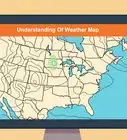This article was co-authored by wikiHow Staff. Our trained team of editors and researchers validate articles for accuracy and comprehensiveness. wikiHow's Content Management Team carefully monitors the work from our editorial staff to ensure that each article is backed by trusted research and meets our high quality standards.
The wikiHow Video Team also followed the article's instructions and verified that they work.
This article has been viewed 690,897 times.
Learn more...
Perfect for a science project or at-home activity, making your own weather barometer is simple and lots of fun. You can make a basic aneroid (air) barometer with a balloon, a jar, and a few other simple supplies. Alternatively, you can make a water barometer with a bottle, some plastic tubing, and a ruler. Either type of barometer will allow you to gauge atmospheric pressure - one of the measurements that meteorologists use to make accurate forecasts.
Steps
Making an Aneroid Barometer
-
1Cut the neck off of a balloon. Using scissors, just snip the end of the balloon right off. There’s no precise place to make the cut. You just want to make sure that the opening will be large enough to fit over the mouth of your jar.[1]
-
2Stretch the balloon over the top of a jar. Use your hands to pull on the opening of the balloon and put it over the mouth of the jar. Pull it down all around so that the balloon is stretched flat over the mouth, with no wrinkles.[2]
- When the balloon is taut over the mouth of the jar, stretch a rubber band over the rim of the jar to hold the balloon in place.
- A glass jar is best, but you can also use a metal can.
- Whether you use a jar or can, the exact size isn't critical. Just make sure that the mouth is not so big that the balloon can't easily stretch over it.
Advertisement -
3Glue the straw on top of the jar. If your straw has a bent end, go ahead and cut that off first. Place a small amount of glue on one end of the straw, and place it so that the end touches the middle of the balloon. The rest of the straw should hang over the edge of the jar. This straw will serve to hold the pointer, allowing you to track changes in atmospheric pressure.[3]
- Silicon glue will work well. You can use super glue, craft glue, or even a glue stick in a pinch, however.
- Make sure to let the glue dry before you move on.
- The longer the straw, the better (as long as it is a straight one). You can even insert the end of one straw into another to make one longer straw.
-
4Attach a pointer. You could tape a needle to the other end of the straw, so that the sharp tip hangs off. If you want something less sharp, cut a small arrow out of cardstock or an index card and insert it into the hollow end of the straw. Make sure it fits snuggly into the end and won’t fall out. This pointer will show how much the straw moves up and down when pressure changes.[4]
-
5Stand some stiff paper next to the pointer. To make things nice and easy, tape a sheet of paper to a wall, and place the jar next to it so that the pointer aims at the paper. Mark the pointer’s position on the paper. Above it, write “high.” Below it, write “low.”[5]
- Stiff paper like cardstock or cardboard will stand up better, but you can use regular paper if that's all you have. You can find lots of options at any store that sells stationery or office/school supplies.
- The pointer should be close to the paper, but not actually touching it.
-
6Record changes in the pointer’s position. As pressure rises, the pointer will aim higher up. When pressure falls, the pointer will, too. Watch the magic happen, and make marks when you notice that the pointer has changed position.[6]
- If you like, you can label the pointer’s initial position “1” and then number each new position in order. This is a great idea if you want to use the barometer for a science project.
- The barometer works because high air pressure pushes down on the balloon, causing the pointer to move upwards, and vice versa.
-
7Interpret the results. Make notes about the weather conditions associated with each change in the barometer's position. When the pointer rises in times of high pressure, is the weather cloudy or clear? What about when the pointer drops during low pressure?
- Low pressure is usually associated with rainy weather. High pressure can mean mild or cooler weather.
Building a Water Barometer
-
1Cut the top off of a plastic bottle. Ordinary two-liter plastic bottles work great. Use one that is empty and clean. Take a pair of scissors and carefully snip the entire top off, down to the point where the sides become straight instead of curved.
-
2Set a ruler inside the bottle. It should stand up inside, flat against the side of the bottle. Put a piece of tape over the outside of the bottle and part of the ruler to hold everything in place. You should be able to see the numbers on the ruler.[7]
-
3Insert clean tubing. The tubing should stop just above the bottom of the bottle. Tape it in place straight against the ruler. It's best to tape the tubing above the water, since tape covered by water may loosen and fall off.
- You will probably need about 40 centimetres (16 in) of tubing to be able to stick up out of the top of the bottle. If your tubing isn't long enough, cut the sides of the bottle so they are lower.
- Leave some of the tubing hanging loose.
-
4Dye some water your favorite color and pour some in. You’ll need enough water to fill the bottle about halfway. Use a few drops of ordinary food coloring to make it extra special.[8]
-
5Suck some of the water into the tube. Use the end of the loose tubing like a straw, and gently suck some of the water up. You’ll want the water to rise about halfway up. Since the water is colored, it should be fairly easy to see.[9]
- Place your tongue over the end of the tubing when the water is in place, to hold the suction and keep the water from going back down.
- Be careful not to suck the water all the way up!
-
6Seal the tubing with something tacky. You could use sticky tack, or even a (used) piece of chewing gum! Take a wad of the tack while your tongue is still over the end of the tubing. Quickly remove your tongue and immediately place the tack over the end of the tubing. This should keep the pressure and hold the water in place.
- You have to work quickly to do this right! If you mess up, just try again.
-
7Mark the water line on the outside of the bottle. When the air pressure rises, the water level will drop in the bottle and rise up the tubing. When pressure falls, the water will rise in the bottle and fall in the tubing.[10]
- You can also mark the changing positions on the ruler, if you like, or just measure how much the water rises and falls.
-
8Study your data. Expect the water in the tubing to rise when weather is clear, and to fall when it is cloudy or rainy. However, if you keep good records with your barometer, you may see that shifts in pressure also happen when weather doesn't drastically change.[11]
- Since your water barometer has a ruler, you can also record pressure shifts as exact changes in inches or millimeters. Use this to notice even very slight changes.
Community Q&A
-
QuestionHow does this work?
 Community AnswerThe balloon forms a seal around the jar, containing the air inside. At the time of sealing, the pressure inside the jar is equal to the air pressure - the straw is therefore level. When the air pressure increases, gas molecules push harder against the balloon from outside than inside, and the balloon is pushed downwards. As a result, the straw pivots upwards. When there is low air pressure, the opposite is true - the gas molecules inside the jar push harder against the balloon than outside, and the balloon is pushed upwards.
Community AnswerThe balloon forms a seal around the jar, containing the air inside. At the time of sealing, the pressure inside the jar is equal to the air pressure - the straw is therefore level. When the air pressure increases, gas molecules push harder against the balloon from outside than inside, and the balloon is pushed downwards. As a result, the straw pivots upwards. When there is low air pressure, the opposite is true - the gas molecules inside the jar push harder against the balloon than outside, and the balloon is pushed upwards. -
QuestionWhat can a barometer indicate about the weather?
 Community AnswerA barometer can only measure air pressure, giving an indication of the expected weather during the following 24 hours. Simply put, high pressure is likely to drive rain bearing clouds away, low pressure will likely let it in, leading to precipitation (rain).
Community AnswerA barometer can only measure air pressure, giving an indication of the expected weather during the following 24 hours. Simply put, high pressure is likely to drive rain bearing clouds away, low pressure will likely let it in, leading to precipitation (rain). -
QuestionDoes the barometer need to be outside?
 Community AnswerYes, it is very important to leave the barometer outside so that it can record more effectively.
Community AnswerYes, it is very important to leave the barometer outside so that it can record more effectively.
Warnings
- Supervise children when they are using scissors and the needle, since both are sharp.⧼thumbs_response⧽
- Balloons are a suffocation hazard and should not be used by small children without adult supervision.⧼thumbs_response⧽
Things You'll Need
Aneroid Barometer
- Scissors
- Rubber band
- Jar
- Tape
- Glue
- Balloon
- Needle or cardboard pointer
- Straw
- Marker
- Cardstock or Hard Index Card
Water Barometer
- Empty two liter bottle
- Ruler
- Plastic tubing
- Tacky substance
- Water
- Food coloring (optional)
- Marker
References
- ↑ https://www.youtube.com/watch?v=ah8F-xmvB2k
- ↑ http://easyscienceforkids.com/make-your-own-barometer/
- ↑ https://www.metoffice.gov.uk/binaries/content/assets/metofficegovuk/pdf/weather/learn-about/met-office-for-schools/diy-activities/make-a-barometer-diy-activity.pdf
- ↑ https://www.science-sparks.com/make-a-barometer/
- ↑ https://www.sciencemuseumok.org/smoathome/try-make-barometer
- ↑ https://www.metoffice.gov.uk/binaries/content/assets/metofficegovuk/pdf/weather/learn-about/met-office-for-schools/diy-activities/make-a-barometer-diy-activity.pdf
- ↑ https://aquarium.ucsd.edu/sites/default/files/2020-06/BirchAqm_DIYOceanBarometerExperiment.pdf
- ↑ https://aquarium.ucsd.edu/sites/default/files/2020-06/BirchAqm_DIYOceanBarometerExperiment.pdf
- ↑ https://aquarium.ucsd.edu/sites/default/files/2020-06/BirchAqm_DIYOceanBarometerExperiment.pdf
About This Article
To make a simple weather barometer with water, cut the top off a plastic bottle and stand a ruler up inside. Tape the ruler down, then tape clean tubing above it. Add a few drops of food coloring to water, then fill the bottle up halfway. Next, suck water halfway into the tubing, seal the tubing, and mark the water line on the outside of the bottle. When the air pressure rises, the water level will drop in the bottle, which correlates with clear weather. When it falls, the water will rise in the bottle, correlating with rainy weather! If you want to learn how to make a barometer with a balloon and straw, keep reading the article!
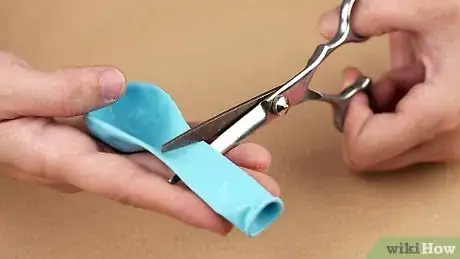

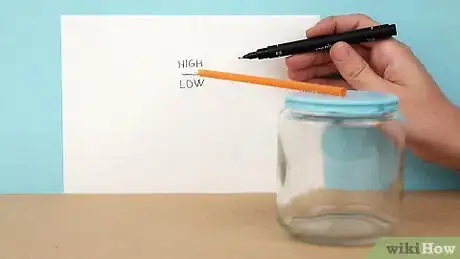
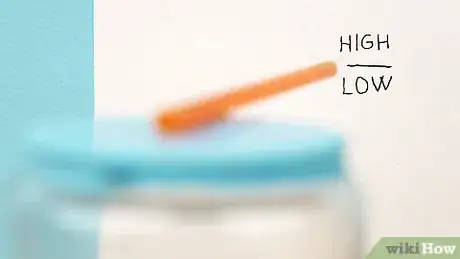
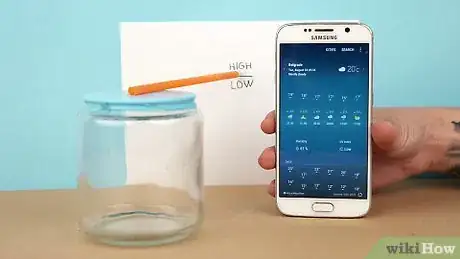
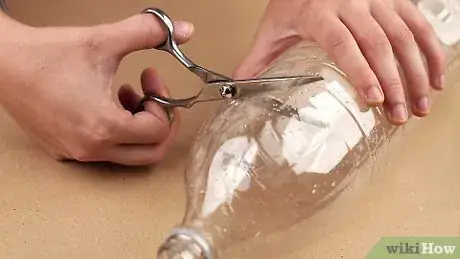

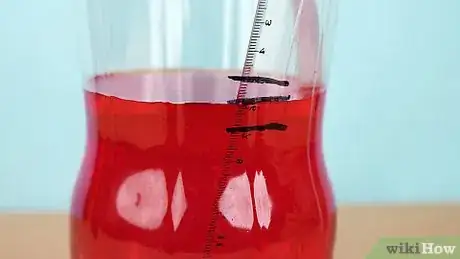
-Step-15.webp)


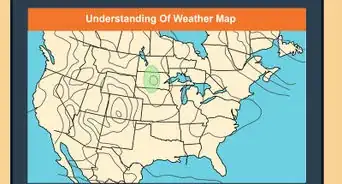
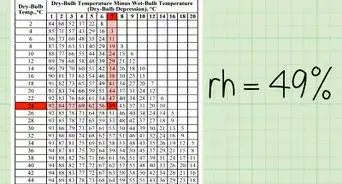
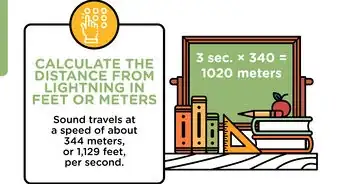
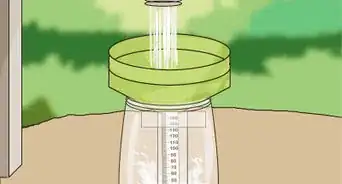
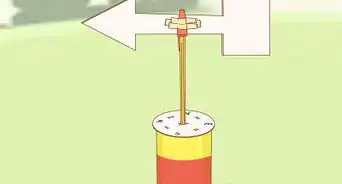
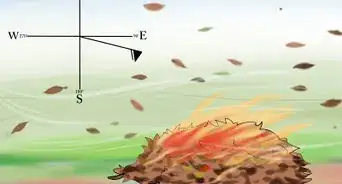
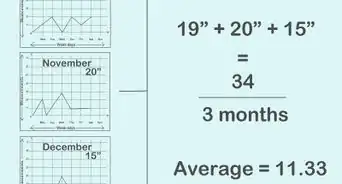














-Step-15.webp)


